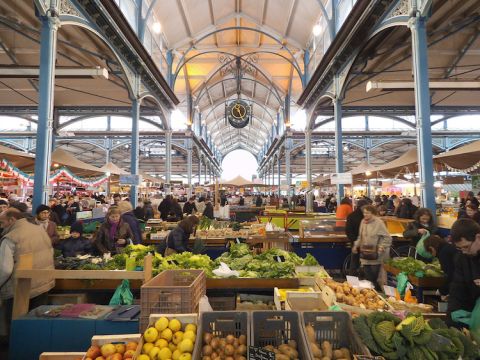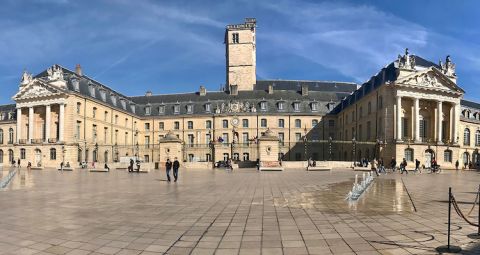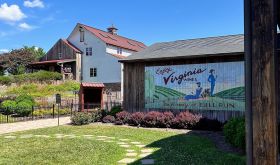26 October 2021 As the OIV announce they are moving their HQ from Paris to Dijon, Dijon resident Matthew Hayes urges us to bypass Beaune and consider a stay in Burgundy's capital, which will have its own ambitious wine and food centre next year.
Dijon is on the up.
Perfectly situated for a northern European weekend break, Dijon sits just five hours’ drive (Rheims and champagne for lunch) from Calais, making it the perfect pit-stop for Brits on the way to the Alps or the Côte d’Azur, an hour and a half from Paris by TGV and just two and a half hours from Geneva, for those from further afield. I recommend a blissfully scenic drive through the Jura rather than the monotonous, and speed-trapped autoroute via Mâcon.
Dijon is Burgundy’s Florence to Beaune’s Siena, albeit both with significantly more rain. Dijon is much the larger with a city now based on 19th-century industrial wealth rather than the single-industry town that is Beaune. For the vinously obsessed, Beaune may be the most logical destination with its very own Piazza del Campo – La Place Carnot – bejewelled with endless smart wine shops and the deliciously aromatic fromagerie Alain Hess. However, beyond the beautiful gothic Hospices de Beaune, its mournful Salle des Pôvres and the quite magnificent Rogier van der Weyden tryptich, it is somewhat culturally limited. My wife rates it as a 45-minute town: ‘on a vite fait le tour’. Although, I’ll add, you can eat pretty well.
Dijon, par contre, has at least enough to fill a weekend and a day with food, culture and wine. Once plagued with poorly parked Peugeots and fume-spewing buses, under the mayorship of ex-employment minister François Rebsamen, Dijon’s centre has been entirely pedestrianised. From the station to the central Place de la Libération is barely a ten-minute walk, and almost everything of interest is within a 500-metre radius; Dijon is as concentrated as Maison Maille’s famous mustards. This extensive rejuvenation has liberated the centre and given justice to a mostly late-Renaissance architecture worthy of the capital of a dukedom that once spread from Lyons to the Hague.
Best appreciated on a balmy spring or autumnal evening, Dijon’s centre is a mass of Gothic churches and vast patrician mansions built in Dijon’s heyday of the sixteenth to eighteenth centuries. If, after 20 years’ living here, I detect one over-riding sentiment that defines Dijon, it is a calm, contented discretion. Such is Dijon’s conservative charm you might feel it is smug, but ceaseless investment has pulled Dijon into the twenty-first century.
This upward movement is to be crowned by the imminent opening of Dijon’s Cité Internationale de la Gastronomie et du Vin. Beating off competition from the likes of Lyons, Tours and Rungis (the site of Paris’s enormous wholesale food market), Dijon was selected in 2012 with a mission to celebrate the idea (or is that ideal?) of ‘French eating and Burgundy’s vineyards and terroir’; both are inscribed on UNESCO’s World Heritage list. Inevitably delayed by COVID-19, the Cité International is expected to finally open its doors in April 2022 on the 6.5-ha (16-acre) site of the old Hôpital Général. This univers gastronomique will host a plethora of restaurants, wine bars, foodie-related shops and wine stores, combined with other elements dedicated to education and culture. The project is nothing if not ambitious.
So, as if this were not enough to entice Purple Pagers to come and visit, herewith a brief list of some of Dijon’s unmissable high points.
Buying food
Fromagerie Porcheret 18 rue Banellier
Dijon’s own Neal’s Yard, complete with glass floor, where, succumbing to the odour of fermented whey, you can gaze down on wheels of Comté cheese et al gently maturing. It’s not just cheese. There is also a little wine and fine charcuterie for a perfect picnic, or the train ride home.
Maison Maille 32 rue de la Liberté
The Maille mustard shop offers a huge range of mustards including refills by the pump – it’s like pouring a pint! An especially fragrant half-pint serving is the moutarde à la truffe. It’s true that Burgundian truffles are but a fragrant penumbra of their Perigord or Albese cousins, but this mustard can be a welcome addition to a well-cooked steak.
Les Halles de Dijon Place des Halles
A temple to food tourism. On market days these nineteenth-century halls and the surrounding streets fill with a vast selection of butchers, fishmongers, cheesemongers and vegetable sellers from around the region and beyond. If in need of a pick-me-up, there’s an on-site wine bar for a fresh glass of Chablis or a restorative glass of Gamay. In season you’ll find mounds of cèpes (porcini mushrooms) and just about anything else gourmet to empty your once-fat wallet. Be warned, one hundred euros is never enough. Open 8 am to 1 pm, Tuesday, Friday and Saturday.
Buying wine
Chez Bruno 80 rue Jean-Jacques Rousseau
Chez Bruno you will find Bruno (plus one) slicing the jambon and serving up one of Dijon’s finest selections of wines by the glass and by the bottle. Chic in its way, Bruno and Chez Bruno have always reminded me of Tim Johnston and Juveniles in Paris; at once, irrepressible and willingly disdainful.
Dr Wine 5 rue Musette (restaurant), 5 Place Notre-Dame (wine shop)
Another Dijon wine operation started by ex sportifs (these were a group of tennis players). The wine shop is solid (you can even buy Prüm) and the restaurant reputed.
Dingovino 9 rue Vauban
Dijon wine shop replete with pépites (nuggets) from across France – Burgundy, the Loire, the Rhône, Languedoc and Champagne – with an accent on organic and biodynamic wines. Wines that are sold with energy and joy and not an ounce of solemnity.
Au Vieux Millésime 80 rue Monge
A long-standing Dijon caviste (literally the only place you could buy a Riesling 10 years ago). A fine selection of top domaines from Burgundy, Jura and pastures wide. Old bottles too, and now with a wine bar attached. It’s just opposite the restaurant-filled Place Émile-Zola.
Caves Carrière 12 rue de Skopje
You’ll need a car, or a bus ticket, to get to Caves Carrière located on the site of Dijon’s old wholesale market near IKEA. A vast selection of more than 3,000 wines with particular depth of Burgundy, not surprisingly, but a decent amount of collateral debris from their international broking operation falls into the palm of opportunity for canny buyers. Tastings available on different hierarchical themes (they need to be booked) such as villages, premier cru, grand cru etc. Best as a stop before the motorway and the long drive home.
Some choice eateries
So 15 rue Amiral Roussin
Enjoyed by Nick here, reservations are essential – every day, lunch and dinner. Cracking value for a cuisine that is European but just slightly Japanese influenced, although that may just be the charm and elegance of the staff. Before starting in Dijon the chef worked in many a top kitchen, Joël Robuchon and Guy Savoy to name but two. This summer a vichyssoise to die for. The wine list is good and great value too.
Hostellerie du Chapeau Rouge 5 rue Michelet
If stars are all that count, William Frachot’s elegant hotel and restaurant is Dijon’s top table. It’s good, but does it make me sing? Not as much as it used to before the prices went up. The best choice is probably the set-course lunch, which is a steal at the price.
L’Oiseau des Ducs 3 rue Vauban
Fancy but conveniently central. Classically orientated, this is, like the Loiseau des Vignes in Beaune, an outpost of the late Bernard Loiseau’s operation at La Côte d’Or in nearby-ish Saulieu. Unusually, they offer wines by the glass from bottles stored in Enomatic preservers. Quite adventurous for a restaurant of this ilk.
La Maison des Cariatides 28 rue Chaudronnerie
At the heart of Dijon’s Quartier des Antiquaires, and just opposite Chez Bruno, Les Cariatides changed its chef and lost its star. This said, it’s a good table and has a long wine list – perfect, unless you have become tired of drinking burgundy.
Arp Caffé 8 rue Vauban
Undoubtedly Dijon’s finest pizzas and home-made pastas, served up with veritable Genovese charm and washed down with a refreshing glass of Lambrusco.
Place Emile Zola, just the wrong side of the city centre for me, is another culinary hot-spot, although even after all these years, I just never seem to get there.
There many more than this selection and you should contemplate the contenders over a Kir, seated in the semi-spherical Place de la Libération (below) with its view of the Palais des Ducs and le Tour Philippe le Bon (both now incorporated into Dijon’s Mairie).
And a spoonful of culture
La Musée des Beaux-Arts de Dijon 1 rue Rameau
An eclectic collection with works from medieval times through to the early twenty-first century, with modern contemporary exhibitions to boot. The focal point of the museum’s fame are the fabulous ducal tombs of Philippe le Hardi and Jean sans Peur, with their scintillating sculpted bases by Jean de Marville and Claus Sluter. There’s enough to fill out a long afternoon or more, with the museum recently reopened after a long refurbishment.
Le Consortium 37 rue de Longvic
On the other end of spectrum, Le Consortium is Dijon’s contemporary art centre. With a small permanent collection and an ever-changing programme, this out-of-centre space provides a refreshing contrast: the shock of the new in a sixteenth-century city! Best avoided when very hot, the atrium can be like a greenhouse.
L’Opera de Dijon, Le Grand Théatre or l’Auditorium de Dijon
Spread across two locations, the ultra-modern, acoustically renowned auditorium and the nineteenth-century splendour of the Grand Theatre, the wide-ranging programme (jazz, classical and opera, to music from the far Orient and everything in between) runs throughout the year. There’s no grand resident orchestra, but its ambition and the quality makes Dijon rank highly in the national musical stakes.
You should also consider taking a walking tour of Dijon’s great noble and bourgeois mansions. De Vogüé don’t just make wine. This influential French family with tendrils from Vaux le Vicomte to the boardroom of Moët et Chandon, the vines of Chambolle and beyond, were also owners of the Hôtel de Vogüé in central Dijon, just one of the many vast Renaissance palaces for Dijon’s erstwhile elite (its roof is pictured at the top of this article). The Dijon Tourist office runs walking tours on Thursdays throughout the year. For wine-loving fans of architecture, this is a hit and will work up a fine appetite (alas, available only in French).
And all of this is just a taste; enough to fill out a weekend before heading home on a Eurostar, sated and laden with the best that Burgundy can offer.
















